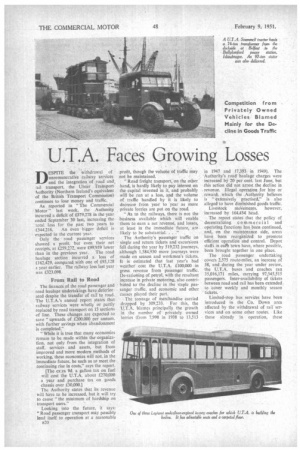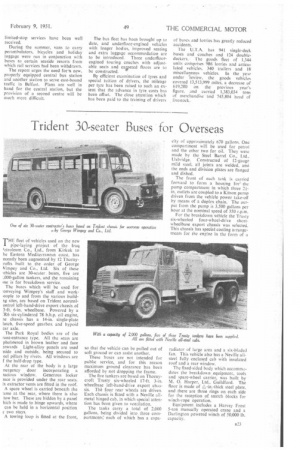U.T.A. Faces Growing Losses D ESPITE the withdrawal of unremunerative railway
Page 54

Page 57

If you've noticed an error in this article please click here to report it so we can fix it.
services and the integration of road and rail transport, the Ulster Transport 4uthority (Northern Ireland's equivalent of the British Transport Commission) continues to lose money and traffic.
As reported in "The Commercial Motor" last week, the Authority incurred a deficit of £379.278 in the year ended September 30 last, increasing the total loss for the past two years to £544,216. An even bigger deficit is expected in the current year.
Only the road passenger services showed a profit, but even their net receipts, at £259,272, were £99,959 lower than in the previous year. The road haulage section incurred a loss of £162,429, compared. with one of £93,128 a year earlier. The railway loss last year was £323,098.
From Rail to Road
The finances of the road passenger and road haulage undertakings have deterior ated despite the transfer of rail to road. The U.T.A.'s annual report states that railway services were wholly or partly replaced by road transport on 13 sections of line. These changes are expected to save "upwards of £200,000 per annum. with further savings when abandonment is completed." "While it is true that many economies remain to be made within the organization, not only from the integration of staff, services and assets, but from improved and more modern methods of working, these economies will not, in the immediate future, be such as to meet the continuing rise in costs," says the report.
[The extra 9d. a gallon tax on fuel will cost the U.T.A. about £270,000 a year and purchase tax on goods chassis over £30,000.] The Authority states that its revenue will have to be increased, but it will try to cause "the minimum of hardship on transport users."
Looking into the future, it says: "Road passenger transport may possibly lend itself to operation at a reasonable ri(l0 profit, though the volume of traffic may not be maintained.
Road freight transport, on the other hand, is hardly likely to pay interest on the capital invested in it, and probably will be run at a loss, and the volume of traffic handled by it is likely to decrease from year to year as more private lorries are put on the road.
" As to the railways, there is not the business available which will enable them to earn a net revenue, and losses, at least in the immediate future, are likely to be substantial. . . ."
The Authority's passenger traffic on single and return tickets and excursions fell during the year by 519,232 journeys, although 1,584,930 more journeys were made on season and workmen's tickets. It is estimated that last year's bad weather cost the U.T.A, £100,000 in gross revenue from passenger traffic. De-rationing of petrol, with the resultant increase in private motoring, also contributed to the decline in the staple passenger traffic, and economic and other causes played their part.
The tonnage of merchandise carried dropped by 309,233. For this, the U.T.A. blames principally the growth in the number of privately owned lorries (from 7,998 in 1938 to 13,513 in 1947 and 17,393 in 1949). The Authority's road haulage charges were increased by 20 per cent. last June, but this action did not arrest. the decline in revenue. Illegal operation for hire or reward, which the ,Authority believes is "extensively practised," is also alleged to have diminished goods traffic.
Livestock movements. however, increased by 164,434 head.
The report states that the policy of decentralizing commercial and operating functions has been continued, and, on the maintenance side, areas have been reorganized to promote efficient operation and control. Depot staffi in ea ett town have, where possible, been brought together in one place.
The road passenger undertaking covers 2,575 route-miles, an increase of 58, and during the year under review, the U.T.A. buses and coaches ran 35,016,171 miles, carrying 97,545,515 passengers. Inter-availability of tickets between road and rail has been extended to cover weekly and monthly season tickets.
Limited-stop bus services have been introduced in the Co. Down area affected by the withdrawal of rail services and on some other routes. Like those already in operation, these limited-stop services have been well received.
During the summer, vans to carry perambulators, bicycles and holiday luggage were run in conjunction with buses to certain seaside resorts from which rail services had been withdrawn.
The report urges the need fort new, properly equipped central bus station and another station to serve east-bound traffic in Belfast. Plans are well in hand for the central station, but the provision of a second centre will be much more difficult. The bus fleet has been brought up to date, and underfloor-engined vehicles with longer bodies, improved seating and extra luggage accommodation are
to be introduced. Three underfloorengined touring coaches with adjustable seats and caipeted floors are to be constructed.
By efficient examination of tyres and special tuition of drivers, the mileage per tyre has been raised to such an extent that the advance in tyre costs has been offset. The close attention which has been paid to the training of drivers of buses and lorries has greatly reduced accidents.
The U.T.A. has 941 single-deck buses and coaches and 124 doubledeckers. The goods fleet of 1,344 units comprises 986 lorries and articti7 lated vehicles. 340 trailers and 18 miscellaneous vehicles. In the year under 'review. the goods vehicles covered 13,513,999 miles, a decrease or 619,200 on the previous year's figure. and carried 1,383,034 tons of merchandise and 745,804 head of livestock.




























































































